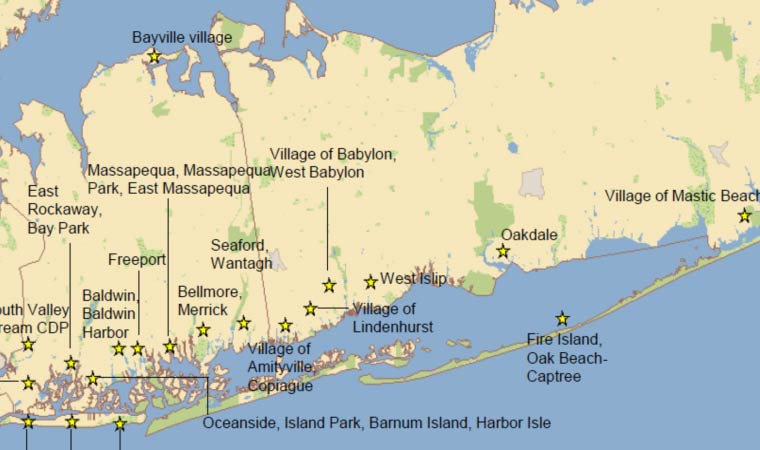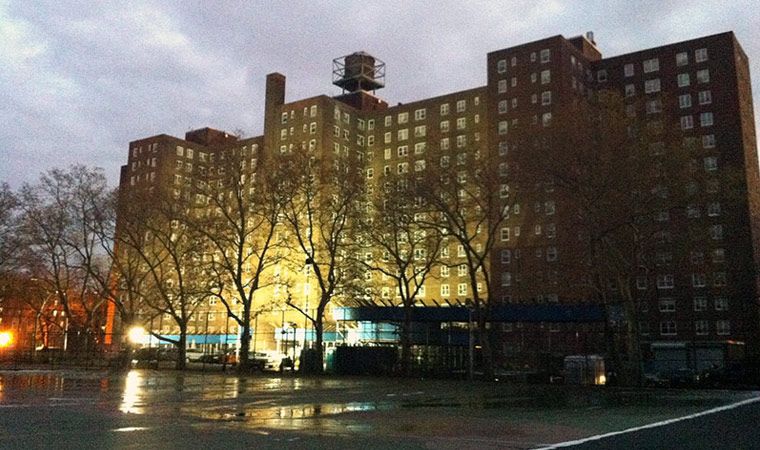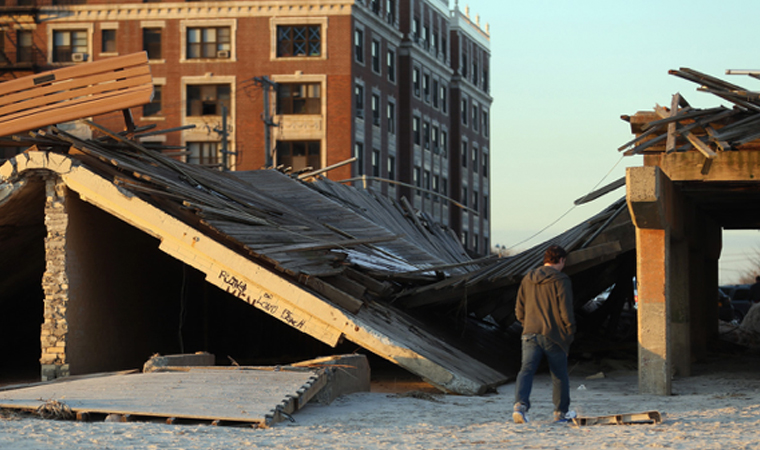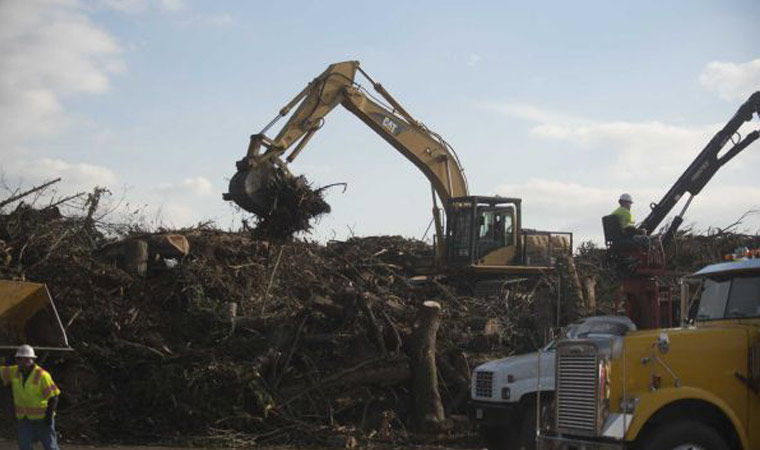- New York Rising
- Community Reconstruction Plans
- New York City Housing Authority
- Long Beach Disaster Management Response and Recovery Services
- Post-Sandy Infrastructure Protection
- Homeland Security Center

New York Rising Community Reconstruction
Various Locations, NY
Show Project Details
In late October 2012 the largest storm in New York’s recorded history swept ashore. Hurricane Sandy’s effect was devastating, causing widespread damage to lives, homes, businesses, core infrastructure, government property and an economy just recovering from the Great Recession. Fourteen counties were declared Federal disaster areas. Sixty New Yorkers died and two million customers lost power with some blackouts lasting up to three weeks. The storm damaged or destroyed as many as 300,000 housing units, affected or closed over 2,000 miles of roads, produced catastrophic flooding in subways and tunnels, and damaged major power transmission and communication systems. It was announced that New York State would receive $1.73 billion of an initial $5.4 billion allocation to assist disaster recovery efforts in areas of the state that had received Presidential Disaster Declaration related to Hurricane Sandy, Hurricane Irene and Tropical Storm Lee. The funds awarded to the State will be administered by the Housing Trust Fund Corporation’s (HTFC) Office of Community Renewal (OCR), operating under the integrated leadership structure of New York State Homes and Community Renewal (NYSHCR).
As stated in the Action Plan, New York State will establish Community Reconstruction Zone (CRZ) planning grants. The State anticipated allocating approximately $25 million from the first allocation to provide planning grants to target communities selected as Community Reconstruction Zones. A CRZ, led by a CRZ Planning Committee, submitted a plan in order to qualify for implementation grants to be included in allocations. Each pre-divided community consisting of various cities and towns formed a Community Reconstruction Zone Planning Committee. The Committee was comprised of representatives from the County, City, Town or Village, elected legislative representatives, members of the public, including representatives of vulnerable populations, as well as the leaders of established organizations and businesses in the community selected by the State in consultation with local officials.
As part of a pre-selected Team of engineers, planner and community advocates, Cameron Engineering & Associates joined forces to support initial community planning efforts and all critical studies to determine the key vulnerabilities and needs of the community which was used to support the creation of CRZ plans. These plans included:
- Action Plan – The Team supported the CRZ Planning Committee as it established goals, set target dates, venues, and purposes of public outreach, reviewed risk assessment maps, and identified the geographic scope of the Plan.
- Public Engagement – The Team was required to assist the committee as it organized, facilitated, and otherwise supports multiple public events.
- Community Asset Inventory – The Team supported the CRZ Planning Committee as it worked with the State to conduct a rigorous analysis of the community’s infrastructure, economy, and assets to determine where the community’s greatest vulnerabilities and opportunities lie.
- Risk Assessment – The Team supported the CRZ Planning Committee as it worked with the State to complete a detailed risk assessment of the community’s assets using a Risk Assessment Tool provided by the State to CRZs, and considered the three factors contributing to risk – hazard, vulnerability, and exposure – and using those risk factors and historical data, estimated the potential consequences an asset faces from future storms.
- Economic Needs and Opportunities Assessment – The Team supported the CRZ Planning Committee as it identified the community’s economic needs and opportunities.
- Housing Needs Assessment and Strategies – The Team supported the CRZ Planning Committee as it developed a housing needs assessment and strategies that helped achieve local housing goals and ancillary activities.
- Regional Planning Projects – The Team supported the CRZ Planning Committee as it produced a list of projects, strategies, and activities that affected or will be affected by ongoing planning in nearby municipalities and at the county and regional level.
- Investment and Action Strategies – The Team supported the CRZ Planning Committee as it developed strategies to rebuild and spur economic growth.
- Completed CRZ Plan -The Team supported the CRZ Planning Committee as it completed a CRZ Plan that included a detailed implementation schedule.

Planning Services to Prepare Community Reconstruction Plans
Herkimer, Oneida, and Madison Counties, NY
Show Project Details
Empire State Development (ESD), in cooperation with the New York State Department of State (DOS), retained Cameron Engineering to work with the State and NYRCR County Planning Committees to complete County-wide NYRCR Plans for Herkimer, Oneida and Madison Counties (includes up to 45 communities).
Each plan included a County-wide risk assessment, the development of resiliency strategies, and accompanying community-specific recovery projects and other actions for severely storm damaged communities in each County.
The team was responsible for the following tasks:
- Developed a work plan for each NYRCR County that identified the steps needed to complete the NYRCR plan, including a budget and staffing plan.
- Prepared a public engagement strategy that specified the level, type, format, and purpose of community engagement throughout the planning process.
- Prepared an overall vision statement for each County that included references to communities with significant storm-damage.
- For each County, prepared an assessment of needs and opportunities related to six core recovery functions: community planning and capacity building; economic development; health and social services; housing; infrastructure; and natural and cultural resources.
- For each County, completed a County-wide inventory of regional and local community assets located within the 100-year flood plain, dam inundation areas, and other areas that traditionally experience flooding.
- For each County, conducted a risk assessment of the assets identified in the Asset Inventory using a Risk Assessment Tool provided by DOS, as well as the HEC-RAS model.
- For each County, further developed strategies to rebuild and spur economic growth. Strategies were specific to each of the storm damaged communities and describe projects, actions, and/or programs to implement those strategies.
- In the communities hit hardest by flooding, identified and described projects and other actions for community reconstruction and revitalization.
- Ensured that the NYRCR Plans for each County were consistent with relevant regional plans.
- For each County, assembled a Draft NYRCR Plan for public review.
- For each County, refined the draft plan and prepared a final NYRCR Plan for the County Planning Committee. The plan included a detailed implementation schedule and a description of how the public has been engaged in development of the NYRCR Plan.

New York City Housing Authority – Post Hurricane Sandy Emergency Services
Various Locations, NY
Show Project Details
Under the NYCHA Hurricane Sandy Capital Improvements Program (HSCIP), Cameron Engineering is performing design engineering services for mechanical, electrical, plumbing, structural, site, civil and landscape architecture at various locations across New York City. As a sub-consultant under this on-going term contract, Cameron Engineering is preparing Basis of Design Reports and Preliminary Design Plans for the restoration of damaged building components at various Developments from the impact of storm surge from Superstorm Sandy. Types of rehabilitation work include central plant boilers, gas piping, and other various types of M/E/P restoration work. At some locations, extensive assessments and photography of site damage was used to determine possible courses of mitigation action. Locations across New York City include:
Betances Houses I Senior Center, The Bronx – New Construction: renovations to the center to restore leak-damaged spaces, ceilings & lighting systems; a new computer classroom; renovation for an ADA-compliant bathroom; and hazardous material abatement; mechanical retrofit: improvement of HVAC via new split-system, and new ventilation ductwork; and related electrical and plumbing upgrades; and structural repairs/ waterproofing: roof repairs
Davidson Houses, The Bronx – Engineering Design Services for HVAC Retrofit work at the Davidson Houses Community Center [Culinary Kitchen] include the retrofit of the air- conditioning system; provide sufficient exhaust and make-up air; Provide an Ansul Fire Suppression System for the Culinary Kitchen cooking equipment; Include all associated Electrical Design, including timer control for spray shower; Include all associated plumbing design, including water and gas lines, grease interceptor, and playground spray shower; coordinate designs with utility companies’ requirements; coordinate design with NYCHA’s other specialties to provide the most efficient solutions; and perform all filings with Authorities having jurisdiction over the Work
Queensbridge Houses North – MEP Upgrade of the Jacob Riis Settlement Community Center. Work included new air conditioning system for the Assembly Hall; renovations to two bathrooms located on the basement floor, below the assembly hall; all associated electrical and plumbing design services; advise and include all required architectural and structural services; coordinate designs with utility companies’ requirements; and perform all filings with authorities having jurisdiction over the work.
Astoria Houses, Beach 41st Street Houses, Ocean Bay-Oceanside Houses – This task involves MEP restoration of the mechanical, electrical and plumbing systems damaged by the storm and associated architectural and structural work. CEA will make the necessary engineering calculations for sizing the generators, provide required design plans and specifications for all required equipment, connections, service improvements and associated architectural or civil designs.
Services at Hammel Houses, Redfern Houses, Astoria Houses and Beach 41st Street Houses – Cameron Engineering sent a team of engineers to each housing development to assess damage; to determine if any pre-existing damage had been exacerbated by the storm; and to survey, photograph, and measure each instance of a sinkhole or a sub-grade ramp that would have accelerated or worsened flood damage to the basements of any buildings.
St. Nicholas Houses and Marcy Houses – Replacement of gas piping which includes Site investigation including limited subsurface utilities / structures location and possible ACM testing, New gas piping layouts at listed Developments; New underground water & fireline piping layouts; Include all associated Electrical and Landscape Design Services as required; Advise and include all required Architectural and Structural Services; Coordinate designs with utility companies’ requirements; and Perform all filings with Authorities having jurisdiction over the Work.

Disaster Management Response and Recovery Services
Long Beach, NY
Show Project Details
After Superstorm Sandy in October 2012, The City of Long Beach required assistance with the management and administration of the Federal Public Assistance (PA) Program including Hazard Mitigation Assistance (HMA), PA Grants Management and development of HMA applications related to Federal Disaster Declaration (DR- 4085) and other recovery services as required by the City.Cameron Engineering is currently assisting staff with PA program compliance, PA Project Worksheet (PW) development and supportive documentation, preparation of submissions to the NYSOEM and FEMA related to the repair/replacement of infrastructure damaged or destroyed, management and administration of grants and grant monies related to PA projects, development and management of HMA grants and projects and the management of other relevant disaster response or recovery funds.
In addition, work involved includes:
- Damage assessments
- Meeting with the City department heads
- Document permit requirements
- Maintain compliance with appropriate building codes
- Work with officials to resolve disputes with FEMA and/or NYSOEM, including preparation of appeals
- Provide Final Inspection and Grant Close-Out Service to ensure funding is retained
- Support the City in providing routine reports and technical data using necessary expertise and technologies
- Negotiate maximum FEMA reimbursement for alternative and improved projects
- Identify and facilitate resolution of special considerations (e.g., historic, environmental, insurance, etc.)
- Provide expertise on interpreting and implementing complex scopes of work
- Provide procurement support for recovery project contractors/ subcontractors
- Provide guidance on FEMA PA policy
- Identify federal and state funding sources to implement post-disaster recovery and reconstruction
- Identify project-specific/post-disaster mitigation opportunities under section 406 of the Stafford Act
- Represent the City during interim and final inspections and project closeouts
- Provide weekly project reports and identify issues affecting recovery
- Assist with audit and compliance issues

Resiliency Experience/Post-Sandy Infrastructure Protection
Various Locations, New York
Show Project Details
Storm Debris Removal for Nassau County – Provided inspection services for documenting post-Sandy debris removal.
NCDPW Environmental – On-call Post-Sandy Services
NCDPW Bay Park Emergency Services – Cameron Engineering provided a team of electrical engineers, civil/sanitary engineers and senior staff to assist in the survey and assessment of damages incurred at the County’s 72 MGD secondary treatment plant. The staff attended daily project team meetings, prepared Damage Assessments, Work Orders and Work Order Justifications to allow the County to pursue reimbursement of the emergency repair costs from FEMA.
Long Beach Recovery Efforts – Cameron is the Project Manager providing oversight and infrastructure assessment on a variety of projects within the City of Long Beach in the aftermath of Hurricane Sandy.
- Negotiations with FEMA for $40+M funding of new 2.2 mile boardwalk
- Synthetic Turf Repair
- Streetscape at Beech St and Park Ave
- Wastewater Treatment Facility
- Indiana St Firehouse/Bulkhead
- Pine St Complex Roof Repairs
- Evaluation of North shore Bulkhead and Outfall Damage
- Grants Assistance
- Comfort Stations
- Municipal Garage Improvements
- Federal Program Assistance
- Roosevelt Ave Pumping Station
- Bayfront Development
Suffolk County Disaster Management, Recovery and Consulting Services – Cameron Engineering is part of a team assembled to provide consulting services for Suffolk County in regard to oversight and management of debris removal and grant management resulting from any future manmade or natural disasters.
NYIT – Vegetative Debris Identification and Debris Monitoring at Old Westbury Campus
Village of Island Park Assessment – Assessment of Sandy damage to Village’s Infrastructure.
Lawrence Sewage Treatment Plant – The Cameron Team conducted initial damage surveys at the facility. We documented storm surge levels, interviewed plant personnel, prepared Damage Assessment Forms and prepared Emergency Work Orders and Work Order Justification Forms to allow County to seek reimbursement from FEMA.
Cedarhurst Water Pollution Control Plant – Work involved conducting initial damage surveys at the facility. The work included documentation of storm surge levels, interviewing plant personnel, preparing Damage Assessment Forms and preparing Emergency Work Orders and Work Order Justification Forms to allow County to seek reimbursement from FEMA.
Sage Lake Sewage Pump Station – The sewage pump station at Sage Lake in the Village of Lawrence was completely submerged and taken out of service after Superstorm Sandy. The Cameron Engineering Team designed new electrical feed and distribution system including LIPA feed, control panel, disconnects, automatic transfer switch, auto dialer and location feed panel all located two feet above surge elevation. The Team coordinated the cleaning of wet well, dry well, and force main. Site visits/tours with FEMA representatives were held, and a report identifying damages, the repair work and recommendations for future hazard mitigation was provided.
North Hempstead Disaster Management – The assessment and remediation effort included the review of the site, the site outings, and the site infrastructure for damage; assess and replace ancillary use assets such as trees, playgrounds, light-posts, etc.; assess and remediate ponds, beaches, piers, seawalls, and parking areas, etc.; the replacement and/or relocation of air handling units, emergency generators, and associated control infrastructure and electrical service components with damaged building spaces; construction cost estimates; and life cycle cost estimates.
City of Long Beach Resiliency Grant – Received a $12.8M New York State Grant for critical infrastructure protection involving deployable moveable barriers and bulkheading.

Homeland Security Center – Long Island Forum for Technology (LIFT)
Bethpage, NY
Show Project Details
The facility focused on the convergence of technology on the Homeland Security market including the Long Island Emergency Operations Center with a 2,000 sf Command Center. The intention was to provide new base building services for the former home of the Lunar Module, Grumman Building #5 home of the Lunar Module (totaling 87,900 sf), and the interior including computer rooms, Sensitive Compartmentalized Information Facility (SCIF) rooms (isolated communications room constructed to facilitate covert discussions), central command center with wall-to-wall large video displays, operator control work stations, lecture hall with multiple video displays, circulation space, egress, emergency generator, UPS and complete security system.
Cameron Engineering provided complete design and construction phase observation services including code compliance review and safety assessments for this nationally recognized Center of Innovation and Excellence for applied science.
The facility included: a new Emergency Management Crisis Contact Command Center, a main computer and communications facility (backbone infrastructure) consisting of satellite (C-band, VSAT) all band terrestrial (for first responders) dedicated cell network, various fiber and Wi-Fi connections to fixed and mobile platforms to enable “real time” data transmission, modeling and simulation lab and digital theatre with touch table and other elements for use as an ultra-high tech command center, an auditorium for user conferences with broadband capabilities to link with other enabling organizations as part of the Virtual Center, secured conference area and network elements for handling classified data integration and display, anchor tenant area – Northrop Grumman Corporation, coordination with major, nationally recognized firms and vendors in the areas of simulation, real-time data, transmission and information technology to accommodate the MEP needs of the Homeland Security Center. PMC (Power Management Concepts) and Balfour Simulation are tenants in the facility.
The Homeland Security Facility Partners include LIPA (Long Island Power Authority), Nation Grid and the Stony Brook Center for Advanced Technologies in diagnostic tools and sensor systems (SENSOR CAT).

